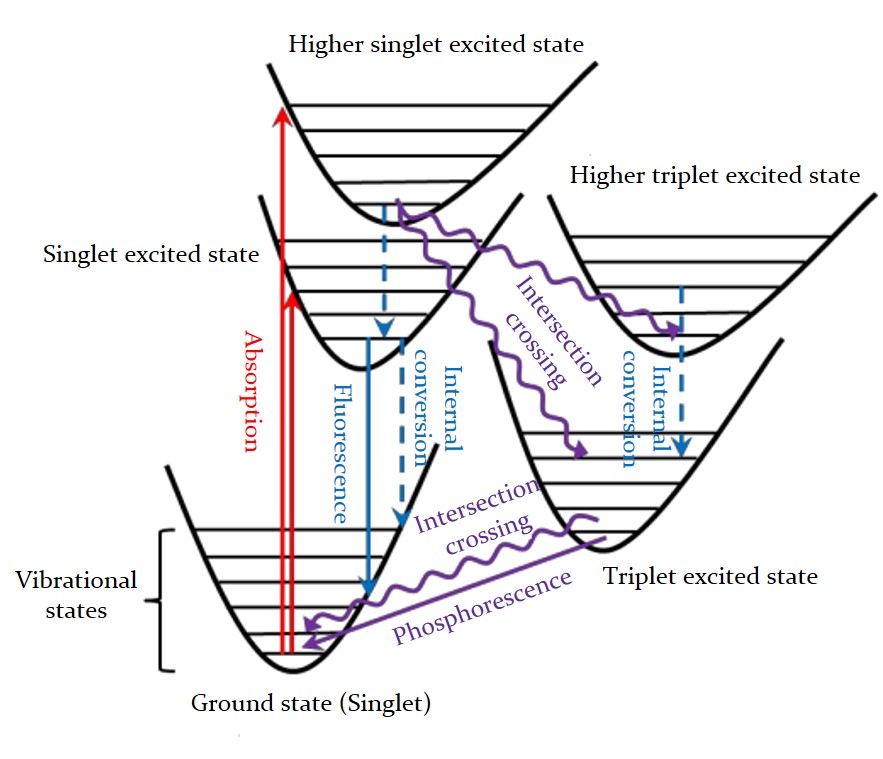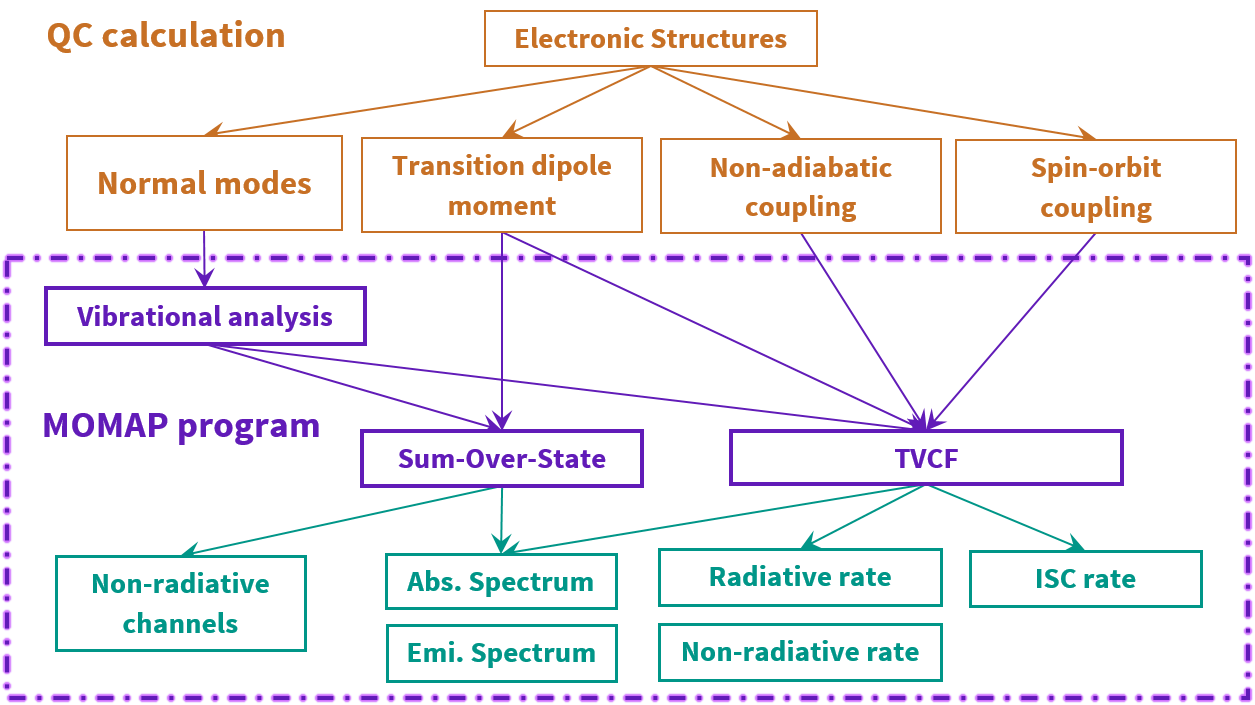Introduction¶
Overview¶
MOMAP (MOlecular MAterials Property Prediction Package) is a suite of codes for predicting properties of polyatomic molecular materials, which is promoted by Prof. Zhigang Shuai’s research group (Department of Chemistry, Tsinghua University) and the Key Laboratory of Organic Solids (Institute of Chemistry Chinese Academy of Sciences).
Current version of MOMAP allows users to study the photophysical properties and charge transport properties of a given molecule or molecular crystal. The first version of user’s guide focuses on introducing theoretical calculations on photophysical and charge transport properties.
On the subject of photophysical properties¶
Excitation, radiative decay and non-radiative decay are the basic photophysical and photochemical processes. They all have massive direct impact on the optical and electrical properties of a molecule.
Key photophysical processes, which can be described by Jablonski energy diagram, are shown in 14834604 . MOMAP can simulate the spectrum of a given molecule, including absorption, fluorescence and phosphorescence spectrum. MOMAP is able to calculate transition rate constants between two electronic states as well, including radiative and non-radiative decay rate constant of internal conversion (IC) process and intersystem crossing (ISC) process.

Jablonski energy diagram
Photophysical properties are tightly connected to various properties of ground and excited states, which are the basis of performing calculations in MOMAP. Its dependencies on common quantum chemistry (QC) calculations are shown in Structrure of MOMAP program .

Structrure of MOMAP program
Key information should be provided in order to perform the calculation, including geometries, single point energy and vibrational modes of ground and excited states, as well as transition dipole moment, non-adiabatic coupling and spin-orbit coupling constant between ground and excited states. The information can be obtained from many other sophisticated quantum chemistry calculation packages, such as Gaussian, TURBOMOLE, NWChem, Dalton, ADF and BDF.
Calculation details are given in the following chapters. There’s also an example in Appendix to help illustrate the process.
Citing MOMAP Photophysics module¶
Users who publish papers based on MOMAP photophysics module calculations are required to cite the following literatures:
- Peng, Q.; Yi, Y.; Shuai, Z.; Shao, J., The Journal of Chemical Physics, 2007, 126, 114302.
- Peng, Q.; Yi, Y.; Shuai, Z.; Shao, J., Journal of the American Chemical Society, 2007, 129, 9333-9339.
- Niu, Y.; Peng, Q.; Shuai, Z., Science in China Series B: Chemistry, 2008, 51, 1153-1158.
- Niu, Y.; Peng, Q.; Deng, C.; Gao, X.; Shuai, Z., The Journal of Physical Chemistry A, 2010, 114, 7817-7831.
- Peng, Q.; Niu, Y.; Shi, Q.; Gao, X.; Shuai, Z., Journal of Chemical Theory and Computation, 2013, 9, 1132-1143.
- Shuai Z. G., Peng Q., Physics Reports, 2014, 537, 123.
Citing MOMAP transport module¶
Users who publish papers based on MOMAP transport module calculations are required to cite the following literatures:
- Geng H., Yin S. W., Chen K. Q., and Shuai Z. G., J. Phys. Chem. B, 2005, 109, 12304.
- Yin S. W., Yi, Y. P., Li, Q. X., Yu G., Liu Y. Q., and Shuai Z. G., J. Phys. Chem. A, 2006, 110, 7138.
- Yang, X. D., Li, Q. K., and Shuai, Z. G., Nanotechnology, 2007, 18, 6, 424029.
- Wang, C. L., Wang, F. H., Yang X. D., Li Q. K., and Shuai Z. G., Org. Electron., 2008, 9, 635.
- Yang X. D., Wang L. J., Wang C. L., Long W., and Shuai Z. G., Chem. Mat., 2008, 20, 3205.
- Nan G., Yang X., Wang L., Shuai Z., and Zhao Y., Physical Review B, 2009, 79, 115203.
- Nan G. J., Wang L. J., Yang X. D., Shuai Z. G., and Zhao Y., J. Chem. Phys., 2009, 130, 8, 024704.
- Wang L., Nan G., Yang X., Peng Q., Li Q., and Shuai Z., Chemical Society Reviews, 2010, 39, 423.
- Wang L. J., Li Q. K., Shuai Z. G., Chen L. P., and Shi Q., Phys. Chem. Chem. Phys., 2010, 12, 3309.
- Shuai Z. G., Wang L. J., and Li Q. K., Adv. Mater., 2011, 23, 1145.